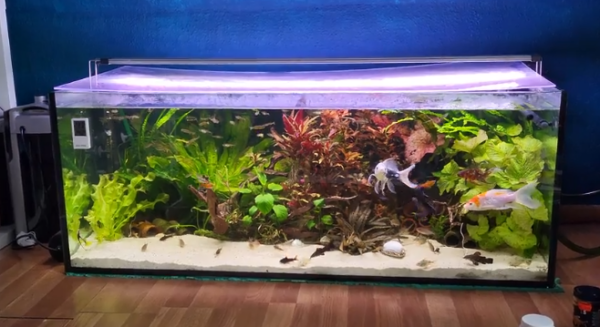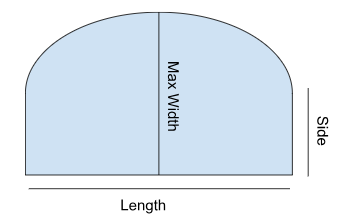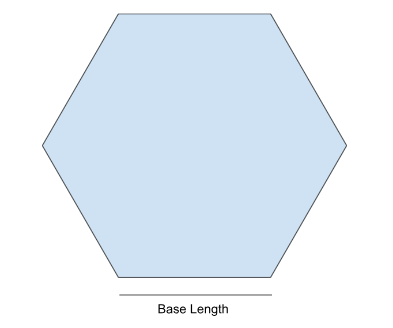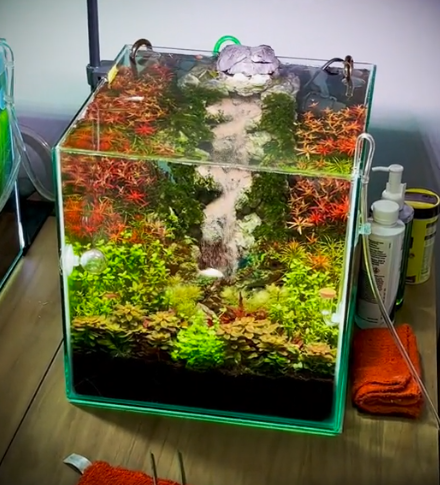The volume of water, measured in gallons and liters, is often enough to conclude if your professional or hobbyist aquarium requirements will be fulfilled or not. However, the weight of water, measured in pounds and kilograms, becomes a necessary consideration when it comes to determining if your floor and the aquarium stand can support the mass.
In this article, we’ll explore the difference between volume and weight, their conversion, and some structural issues that you need to assume before starting your tank.
Table of Contents
Understanding Gallons, Liters, Pounds, and Kilograms

Gallon (gal) and liter (L) are the units of volume in different systems of measurement. Two different versions of gallons are currently in use in the United States. But for our purpose, we’ll talk only about the US gallon (or gallon) throughout the article and disregard US dry gallon (“usdrygal”) for obvious reasons.
Gallon is defined as 231 cubic inches (0.13 cubic foot) and 3.78 liters at 39.16°F.
In simple words, it means that for every 231 cubic inches of tank space, you’ll need exactly 1 gallon (or 3.78 liters) of water to fill it.
Pound (lb) and kilogram (kg), respectively, are the units of mass in the US customary system and metric system. Internationally, 0.45 kilograms are accepted as 1 pound.
Calculating the Volume of Your Aquarium
The fundamental idea is that you need three dimensions (length, width, and height) to calculate the volume (gal or L), but it may prove to be a bit more challenging with irregularly shaped tanks. Here is a basic overview of the calculations that you’ll need to measure the volume of your fish tank:
Rectangular Aquariums
The most common rectangular aquariums also are the easiest to measure. You can calculate its volume by tape measuring the length, width, and depth (height) of the tank.
The volume= length × width × height
For example, A rectangular aquarium of 36 inches in length, 18 inches in width, and 24 inches in height will have a volume = 36*18*24 cubic inches = 67 gallons (considering 1 gal = 231 cubic inches).
Also Read: How To Choose An Aquarium Tank Size – Ultimate Guide
Cylindrical Aquariums
Cylindrical aquariums mostly feature in public places, offering a 360-degree view to the public. However, you may consider them as a centerpiece in your home if you have enough space to showcase them in the middle.
You need the radius and the height of the tank to calculate the volume. Measuring the radius may be a bit tricky, but you can tape measure the diameter and divide it in half.
The volume of a cylinder = π x radius2 x height
For example, a cylindrical aquarium with a radius of 12 inches and a height of 18 inches will have a volume = 3.14*12*12*18 cubic inches = 35 gallons.
Bowfront Aquariums
A rapidly growing design, bowfront aquariums fit perfectly against flat walls and have a convex front to offer more swimming space and better external visuals. Measuring the volume of it, however, requires a bit of heavy calculations.
You’ll need the length of the tank (wall side), side length, height of the tank, and max-width to calculate the volume of a bowfront aquarium.

Volume = (Height x Width x Length) + (0.5 x π x (Length/2) x (Max width – Side) x height)
For example, a 40-gallon bowfront aquarium might have a length of 24 inches, a side of 18 inches, a max width of 22 inches, and a height of 18.75 inches.
Half Cylindrical Aquariums
Half-cylindrical aquariums are particularly popular in homes with limited space. The shape snuggles with the wall without wasting any space while giving off an experience similar to cylindrical tanks. Determining the volume of a half-cylindrical aquarium requires only the measurements of its radius and height.
Note: The length of the half cylinder is its diameter.
Volume = 0.5 x π x radius2 x height
For instance, imagine a half-cylindrical aquarium with a radius of 10 inches and a height of 24 inches. Its volume would be calculated as follows: 0.5 x 3.14 x 10 x 10 x 24 cubic inches = 3768 cubic inches = 16 gallons.
Regular Hexagon Aquarium
Six-sided regular hexagon aquariums bring a geometric charm to any aquatic setting, offering a visually striking alternative to traditional rectangular or cylindrical tanks. Allowing flexibility, hexagon tanks can be featured against the wall, in the corner, or the middle of the room.
Calculating the volume of a regular hexagon aquarium requires measurements of the side length and height.

Volume of a regular hexagon aquarium = (2.59) x base length2 x height
For example, consider a regular hexagon aquarium with a side length of 12 inches and a height of 20 inches. Its volume would be calculated as: 2.59 x 12 x 12 x 20 cubic inches = 32 gallons
Corner Cylindrical Aquarium
Corner cylindrical aquariums are ideal for tight corners or areas where space is at a premium, providing a visually captivating focal point. These tanks occupy only a quarter of the space of a full cylinder, potentially staying in one corner, and still boasting a curved viewing pane. Calculating the volume of a quarter cylindrical aquarium requires measurements of both its radius and height.
The volume of a quarter cylinder = 0.25 x π x radius2 x height
For example, a corner cylindrical aquarium with a radius of 18 inches and a height of 20 inches will have a volume of: 0.25 x 3.14 x 18 x 18 x 36 cubic inches = 40 gallons.
Also Read: Best Betta Fish Tanks To Choose From: Top 10
Gallon to Pounds Conversion

With the volume of common aquarium shapes out of the way, let’s get to the gallon-to-pound conversion.
For general calculations and rough estimations, you may assume 1 gallon of water at room temperature = 8.329 pounds. Therefore, 50 gallons of water will weigh around 416 pounds. However, it’s only accurate when it’s water at room temperature without any additives, which mostly isn’t the case when it comes to aquariums.
Your tank’s total mass will also include the stones, glass, cover, and other accessories. Moreover, saltwater weighs more than freshwater.
Gallon to Kilograms Conversion
Assuming consistent conditions, 1 gallon of water at room temperature typically weighs approximately 3.75 kg. Consequently, if you were to measure 50 gallons of water, the scale would display approximately 189 kg. The factors, such as saltwater and water temperature, mentioned for converting gallons to pounds remain applicable for converting gallons to kilograms as well.
Also Read: 7 Best 30 Gallon Fish Tank Kit
Effect of Variables on Water Weight
The weight of your aquarium water can be influenced by several variables, including:
Temperature
Water density changes with temperature. Increased temperature causes thermal expansion and allows the water molecules to take up more space, reducing density. Therefore, if you were to measure a fixed volume of water at different temperatures, the higher-temperature water would weigh less. Consecutively, lower temperature increases density and weight.
Salinity
Dissolved salt in your saltwater aquarium can introduce a positive gradient to the water weight. It increases the density of the water, and although the effects are small, it can be significant in larger tanks. Typical saltwater aquariums have a salinity level of 35ppt, which calculates to 8.54 lbs per gallon of saltwater, which is a bit higher than freshwater (8.329 lbs).
Evaporation
Evaporated water leaves minerals and salts behind, increasing the density. Therefore, the weight of the remaining water may be slightly higher than fresh water.
Additives
Water conditioners, fertilizers, and medications can alter the water weight slightly. However, the changes often are insignificant enough to be disregarded in calculations.
Application and Relevance of Water Weight
Your floor and the basic stands can easily support the weight of smaller aquariums. But the issue arises when your fishkeeping hobby demands something more: a larger aquarium. A tank with hundreds of gallons of water is a structural challenge that you need to consider even before entertaining the idea.
In our experience, a 75-80 gallon tank can easily breach the 800 lbs mark with the added weight of rocks, stand, and the frame. This, in addition to the weight of the occasional group of audience, will need your floor to support at least 1500 lbs of weight in a given instance around the tank. Being able to calculate the water weight helps you get an estimate of whether the floor can support it or if you need to make other arrangements like floor joists and outdoor settings.
Also Read: 9 Best 3 Gallon Fish Tank Kit
FAQs
A 20-gallon tank can weigh anything between 170 to 200 lbs, depending on the substrate, frame, and accessories used. However, the raw weight for 20-gallon water is 166.8 lbs or 31.6 kg.
1 gallon of water weighs 8.34 lb or 3.79 kg at room temperature.
Temperature, salinity, additives, and evaporation influence water weight per gallon. As long as the mercury is over the freezing point, a lower temperature increases water density and per volume weight.
The Bottom Line
We’ve answered the weight of a gallon of water in pounds and kilograms with all the necessary details you may need. We also have discussed the calculation formulas for each aquarium type to help you swiftly determine their weight. Hopefully, you’ll now be able to find the right location and hardware for your new tank and aquatic friends. All the best!
